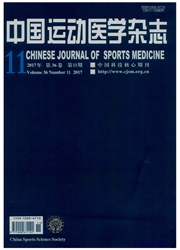

 中文摘要:
中文摘要:
目的:探讨半月板纤维软骨细胞(MFCs)接种脱钙松质骨(DCB)支架的最佳接种方法。方法:实验分静滴法、注射法、离心法、负压法等4组。取兔MFCs,采用上述4种方法对孔隙率为80%、平均孔径为268μm的DCB支架进行细胞接种。Live/Dead染色检测其细胞活性,并通过软件分析其细胞分布情况。CCK-8法和Hoechst 33258法检测支架内MFCs增殖情况和支架内DNA含量。结果:通过Live/Dead染色显示,离心法接种细胞后其存活率优于其他3组(P〈0.05);细胞分布均匀,由浅至深各层细胞比例无明显统计学差异(P〉0.05);1~5天细胞增殖能力优于其他3组(P〈0.05),14~21天支架DNA含量亦优于其他3组(P〈0.05)。结论:离心法可以明显提高MFCs在DCB上的细胞分布和细胞增殖能力,是一种简单、高效的,利于组织工程半月板(TEM)构建的接种方法。
 英文摘要:
英文摘要:
Objective The purpose of the study is to explore an optimal method for seeding meniscal fibrochondrocytes(MFCs) into demineralized cancellous bone(DCB) scaffolds. Methods Statics,injection,centrifugation and vacuum methods of inoculation were used to seed the MFCs into the DCB scaffolds(composed of 80% porosity and 268 μm pore size). Cell viability was assessed by fluorescence staining and its distribution by a softwear of reconstructed three-dimensional image. The Cell Counting Kit-8 assay and DNA assay were employed to assess the cell proliferation. Results The survival rate of the MFCs were significantly improved via centrifugal seeding as compared to the other three seeding methods(P 〈0.05).Seeded MFCs using centrifugation revealed more homogeneous distribution throughout the scaffold as compared to the other three seeding methods. There was no significant differences in the penetration depth in the scaffold of seeded MFCs by the three seeding methods(P〉0.05). The reproductive activity of MFCs in day1 to 5 and the level of DNA in the scaffold in the day 14 to day 21 of the centrifugal group surpassed the other three groups(P 〈0.05). Conclusion The centrifugal seeding method could significantly improve MFCs distribution and proliferation on the DCB scaffolds,providing a simple and effective cell-seeding procedure for tissue-engineered meniscus.
 同期刊论文项目
同期刊论文项目
 同项目期刊论文
同项目期刊论文
 Potential of centrifugal seeding method in improving cells distribution and proliferation on deminer
Potential of centrifugal seeding method in improving cells distribution and proliferation on deminer Comparative study on immediate versus delayed meniscus allograft transplantation: 4- to 6-year follo
Comparative study on immediate versus delayed meniscus allograft transplantation: 4- to 6-year follo Second-look arthroscopic evaluation of chondral lesions after isolated anterior cruciate ligament re
Second-look arthroscopic evaluation of chondral lesions after isolated anterior cruciate ligament re Repair of large full-thickness cartilage defect by activating endogenous peripheral blood stem cells
Repair of large full-thickness cartilage defect by activating endogenous peripheral blood stem cells Meniscus transplantation using treated xenogeneic meniscal tissue: viability and chondroprotection s
Meniscus transplantation using treated xenogeneic meniscal tissue: viability and chondroprotection s Double-bundle anterior cruciate ligament reconstruction using bone-patellar tendon-bone allograft: t
Double-bundle anterior cruciate ligament reconstruction using bone-patellar tendon-bone allograft: t 期刊信息
期刊信息
